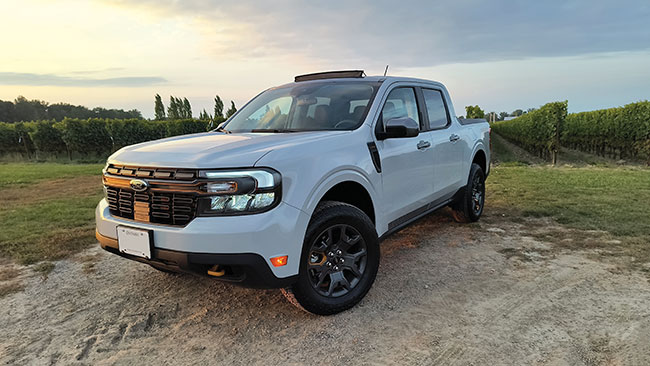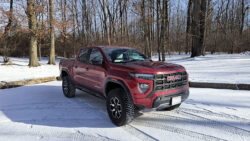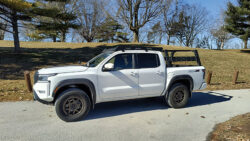
Right sizing your truck fleet
By Mario Cywinski
Features Business IntelligenceThree different mid-size pickup trucks to consider for your fleet.
 Ford Maverick XLT with Tremor off-road package
Photo credit: Mario Cywinski
Ford Maverick XLT with Tremor off-road package
Photo credit: Mario Cywinski Commercial work pickup trucks are the lifeblood of many industries. While many opt to get a full-size pickup truck, either as a 1500 or heavy-duty (2500 and above), for many these trucks are either too big, too expensive, or not what they need. That is where mid-size pickups come in. While on the way out of favour a few years ago, they are now back with many new models on the market.
We reached out to various OEMs to drive what they have available. What we have are three midsize trucks that each come to the dance in a different set of clothes. The Ford Maverick is the smallest of the three trucks and the only one which is a unibody. The Nissan Frontier is the most truck-like of the three and is a body-on-frame. The final truck is the GMC Canyon and it is the one which is a body-on-frame but drives like a unibody.
Ford Maverick
While most of the pickup truck attention and sales for Ford are the F-Series (F150 and Super Duty), Ford does offer two pickup trucks that are in the smaller range. First is the long-running mid-sized Ranger, and second is the smaller Maverick. Both trucks are fit for purpose, as many companies do not need a full-size pickup truck to do the needed job, and these two are more of a right size option.
Having recently driven the smaller Maverick XLT with Tremor off-road package, lets focus on that. The Maverick feels more like driving a SUV than a large pickup truck. This can be attributed to the fact it is a unibody, and not a body-on-frame (like larger trucks). For those who prefer a more refined drive, this truck delivers that.
For 2024 the biggest change is the standard engine now being the 2.0-litre EcoBoost mated to an eight-speed automatic transmission, with the 2.5L hybrid mated to a CVT being the optional engine and only available on front-wheel-drive models. Basically, Ford has flipped things with what is standard and what is optional.
The standard inline-four turbocharged engine offers 250 horsepower and 277 pound/feet of torque, while the inline-four hybrid engine offers 162 hp (191 hp combined with hybrid system), and 155 lb/ft of torque. The hybrid system offers 94 kilowatts of power from its electric motor. While the hybrid is only available in front-wheel-drive, the turbocharged engine comes standard with all-wheel drive.
As a result of the Maverick’s smaller size, the engine never felt like it was struggling. Having driven both versions of the vehicle at different points in time, both felt responsive and enough for the vehicle. The EcoBoost is obviously the more powerful option and does a better job while towing or with any payload, however, the hybrid is enough for most fleets.
Capability is one of the main aspects that are needed in a work truck, namely payload and towing. Looking at payload, both engine options offer 1,500 lbs of capacity (with the models featuring the Tremor off-road package offering 1,200 lbs). Towing capability is 2,000 lbs, with the 4K tow package on AWD EcoBoost models doubling that to 4,000 lbs.
The second most important aspect of a pickup truck is the cargo capacities. The Maverick has a cargo volume of 33.3 cubic feet, an exposed cargo width of 53.3 inches, a pickup body length (floor) of 54.4 inches and a lift-in height of 30.1 inches on Hybrid models, or 30.5 inches for EcoBoost and models with the Tremor package. Interior passenger volume is 100.3 cu/ft on the Hybrid, 98.3 cu/ft on the EcoBoost AWD or 101.5 cu/ft on models featuring the Tremor package.
Safety is also important and the Maverick comes with many of Ford’s Co-Pilot 360 technologies: standard are auto high beams, pre-collision assist with automatic braking and rearview camera. Optional are adaptive cruise control with stop and go, steering assist, lane centering, reverse sensing system, blind spot monitoring, lane departure warning, lane keeping and hill descent control.
The Maverick with the Tremor package I drove was equipped with many safety features and it gave the driver an added sense of security. For those workers who spend a lot of time of the road, getting the added safety features is a must, as it gives both the company and driver more peace of mind.
The Maverick sees other smaller changes for 2024, with package, colour and elimination of some stand-alone options.
GMC Canyon
While Ford offers two mid-size/compact trucks that are of different sizes, General Motors does things differently. They have two trucks that are on the same platform, but with different badges and trim structures. The GMC Canyon and Chevrolet Colorado are both similar vehicles, with the GMC being looked at as the more “premium” work truck. Having driven the Canyon AT4X recently, let’s look at it.

GMC Canyon with AT4X trim
Like it’s larger sibling, the Sierra, the Canyon is a body-on-frame model. While many larger pickups that are body-on-frame can have a rougher ride, the Canyon is a very smooth ride. It is one of the smoothest riding mid-size pickups available. As a result, for a minute I thought that it was a unibody, before double checking to see that in fact it is a body-on-frame.
The Canyon comes standard with a 2.7L turbocharged inline-four engine offering 310 hp and 430 lb/ft of torque mated to an eight-speed automatic transmission. The engine comes with active fuel management and stop/start.
Of the three trucks, the Canyon has the best payload capacity, however, this is only for certain trims levels, as the range goes from 1,010 to 1,590 lbs. In terms of towing capacity, the GMC once again comes out on top with certain trims being at 7,700 lbs (other trims come with 6,600 and 5,500 lbs of capacity).
As the Canyon was in AT4X trim, the highest available, this was also the nicest looking truck of the three. With the most refined interior and best fit and finish.
The Canyon comes with standard automatic emergency braking, following distance indicator, forward collision alert, lane keeping assist and warning, and buckle-to-start, while available features include blind spot steering assist, rear cross traffic braking, rear park assist and rear pedestrian alert.
One thing to keep in mind on the Canyon is that it has no physical headlight button or knob. The headlights are controlled with the centre infotainment screen. Maybe I am old, as I spent a good amount of time trying to find how to turn the lights on.
Nissan Frontier
With the drop of the full-size Titan from the Nissan lineup, the mid-size Frontier is the only truck remaining in the company’s Canadian portfolio.

Nissan Frontier Crew Cab Pro-4X with Nismo accessory package
The vehicle that was tested was a Crew Cab Pro-4X with nearly $17,000 worth of Nismo accessories. Now most of these were for off-roading, however, some can be used by fleets. They included roof rack, high overlanding rack, bronze truck wheels, high performance front and rear suspension kit, forged upper control arms, A-pillar light mounts and four-inch round lights, cat-back exhaust and hood graphic.
Nissan offers a 3.8L V6 DOHC engine in the Frontier, outputting 310 hp and 281 lb/ft of torque mated to a nine-speed automatic transmission. It is the only one of the three with a six-cylinder engine instead of a turbocharged four. While the vehicle was slightly sluggish going up steep hills, that could be attributed to the accessories that were part of the vehicle. Under all other operation, it provided enough power.
Fuel economy is listed at 12.8 to 13.1 L/100 km in the city, and 10.2 to 10.5 L/100 km on the highway, depending on the trim level. Obviously, these numbers will fluctuate depending on the payload, towing or how many Nismo accessories you have.
As the most truck-like of the three vehicles that were driven, the Frontier also has the harshest ride. However that is not to say it is not comfortable, it just feels more like a larger truck. It also offers a much larger towing capacity of between 6,170 and 6,220 lbs, depending on the trim level.
The Frontier is also the only one of the three trucks to offer two bed lengths, with a cargo bed volume of 40.1 inches (standard bed) or 49.2 inches (long bed with a spray-in bedliner). How much payload can you put into the bed? Anywhere between 1,050 and 1,200 lbs, depending on the trim level.
Unlike, so other models on the market, the Frontier offers all its safety features as standard equipment. That includes lane departure warning, blind spot monitoring, rear traffic alert and automatic braking, adaptive cruise control and forward collision warning, and a rear sonar system.
What the midsize truck segment shows is, unlike the larger 1500 level and above trucks, one size does not fit all. These trucks come not only in different sizes, payloads and designs, but, most importantly, they come differently fit for purpose. Everything from a pure truck template to a recreational SUV with a bed template. And of course, everything in between.
Which truck is right for you?
ABOUT THE AUTHOR
Mario Cywinski has worked in the automotive industry for nearly 20 years. He is a member of the Automobile Journalist Association of Canada.
Print this page